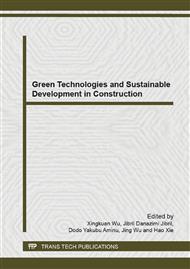[1]
R.H. John, High-rise Building Fires, National Fire Protection Association Fire Analysis & Research, Quincy, MA, 2011, p.4/42.
Google Scholar
[2]
C. Yu, Fire Behavior of Commonly Used Organic Exterior Insulation Materials under Vertical Wall Condition. China: University of Science and Technology of China. 80. (2012).
Google Scholar
[3]
D.A. Fidler, A.A. Lacey, Dynamics of Vertical Fire Spread, IMA J. Appl. Math., 2012, pp.1-27.
Google Scholar
[4]
C. Qian, H. Ishida, K. Saito, Upward Flame Spread along PMMA Vertical Corner Walls Part II: Mechanism of M, Shape Pyrolysis Front Formation, Combust. Flame. 99 (1994) 331-338.
DOI: 10.1016/0010-2180(94)90138-4
Google Scholar
[5]
T.B. David, Comparing the Performance of Residential Fire Sprinklers with Other Life-safety Technologies, Accid. Anal. Prev. 48 (2012) 480-494.
DOI: 10.1016/j.aap.2012.03.006
Google Scholar
[6]
General Administration of Quality Supervision, Inspection and Quarantine of P.R.C. and Ministry of Housing and Urban-Rural Development of the P.R. C, Code for Fire Protection Design of Tall Buildings, GB50045-95, 27-33. (1995).
Google Scholar
[7]
General Administration of Quality Supervision, Inspection and Quarantine of P.R.C. and Ministry of Housing and Urban-Rural Development of the P.R. C, Code of Design on Building Fire Protection and Prevention, GB50016-2006, 44-53. (2006).
Google Scholar
[8]
National Fire Protection Association, Standard for the Installation of Sprinkler Systems (2010 ed. ), Quincy, MA 02169, 45-92. (2010).
Google Scholar
[9]
National Fire Protection Association, Standard for Fire Doors and Other Opening Protectives, Quincy, MA 02169, 16-37. (2007).
Google Scholar
[10]
National Fire Protection Association, Recommended Practice for Protection of Buildings from Exterior Fire Exposures (2007 ed. ), Quincy, MA 02169, 5-13. (2007).
Google Scholar
[11]
Y. Sakumoto, T. Hirakawa, H. Masuda, K. Nakamura, Fire Resistance of Walls and Floors Using Light-Gauge Steel Shapes, J. Struct. Eng. 129 (2003) 1522-1530.
DOI: 10.1061/(asce)0733-9445(2003)129:11(1522)
Google Scholar
[12]
J.H. Mammoser, F. Battaglia, A Computational Study on the Use of Balconies to Reduce Flame Spread in High-rise Apartment Fires, Fire Saf. J. 39 (2004) 277-296.
DOI: 10.1016/j.firesaf.2003.11.011
Google Scholar


